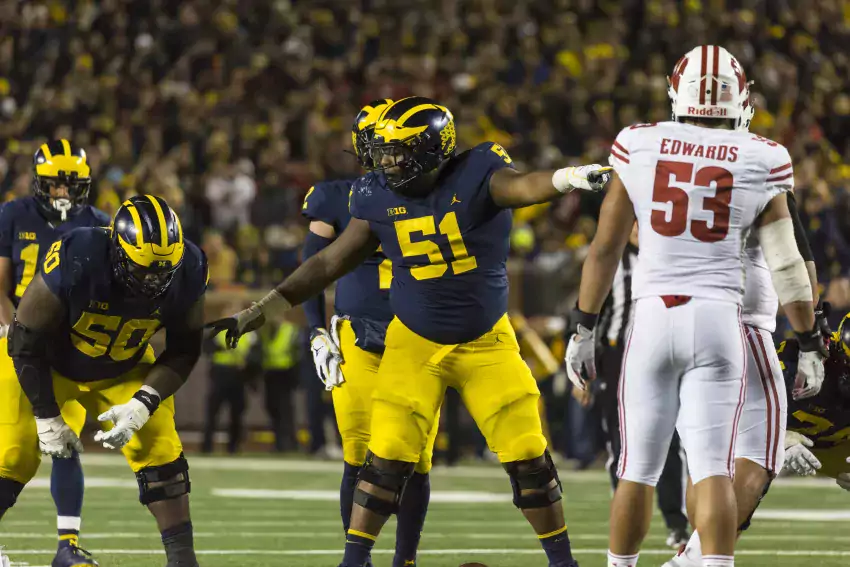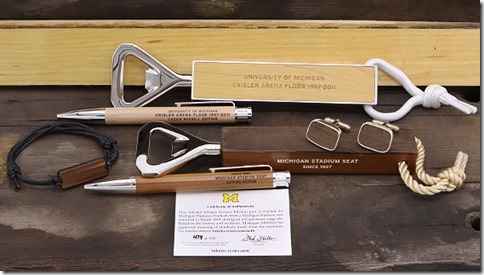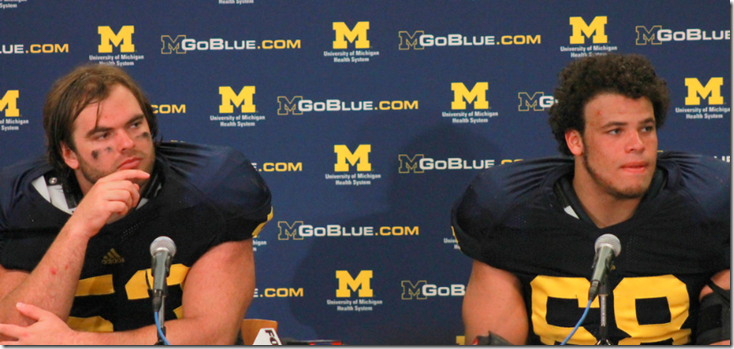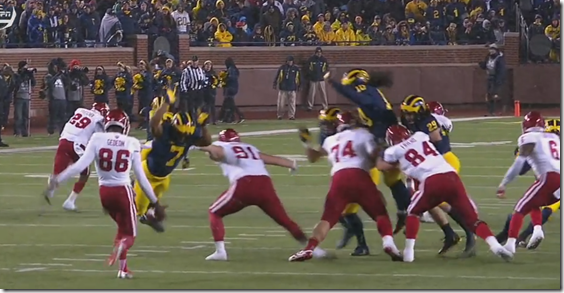punt returns

Previously in this series covering the 2010s: Favorite Blocks, QB-RB-WR, TE-FB-OL, Defensive Line, Linebacker, Secondary, Worst Calls, and Dumbest Plays so might as well do the flipside.
This post has a sponsor. Speaking of smart plays, if you’re lookin for a gift to celebrate dads or grads, Michigan Stadium Products makes stuff out of the original Michigan Stadium bench seats and Crisler Arena playing surface, like a pen with a COA signed by Cazzie Russell. MGoBlog readers enjoy a 10% discount on all purchases by using code DADGRAD20 through 6/15.
Take a closer look at the Victors Edition Stadium pen, Stadium cuff links, Cazzie Edition Crisler pen, Crisler bottle opener (almost sold out!), and Michigan Stadium bracelet. Order in time for Father's Day and graduation gifts!
10. Martin and Van Bergen, Coaches at Large
2012 SUGAR BOWL
Football hmmm… [Eric Upchurch]
The press got word after the 2011 Ohio State game that senior DTs Ryan Van Bergen and Mike Martin had been given the green light by their coaches to make the line calls for each play, including when and how to stunt. That in itself wasn’t highly remarkable; the modern Michigan equivalent of RVB’s position, the Anchor, makes line calls for the defense today. The reason it goes down in the lore of these guys is they got so good at it.
They were also the two who lined up and dove into the A gaps to stop VT’s hurry-up 4th and 1 sneak, called the slant that got Frank Clark in to intercept a screen pass, and the slant that got Jake Ryan inside the tackle then chasing inside out on the ensuing rollouts. RVB was doing it on a broken foot too.
-Seth
[After THE JUMP: Glasgows be here]
Sea of red. Georgia played Notre Dame last weekend and this is what it looked like:
Old friend of the blog Braves and Birds has an article about this remarkable screenshot, pointing out that this was literally a once in a lifetime opportunity for Georgia fans and they reacted accordingly. Somewhat similar scenes might play out if other fanbases were afforded an opportunity to go see a college football cathedral instead of a sterile NFL stadium that still smelled of Phil Simms:
...the reaction of Dawg fans to the chance to travel to South Bend is a reminder that there is huge, untapped demand among big college football fan bases to see their teams play other elite programs on the road and not at NFL stadiums.
One way to illustrate this point is to look at how the most popular programs have never visited one another. Here are the top 10 in attendance from 2016: Michigan, Ohio State, Texas A&M, Alabama, LSU, Tennessee, Penn State, Texas, Georgia, and Nebraska. There are 90 potential home-and-home combinations among those teams. In over a century of football, 33 of these matchups have never happened. That’s a bevy of road trips that big fan bases have never gotten to take.
I say "somewhat" because Notre Dame is especially vulnerable to this kind of takeover because of the nature of their fanbase and ticketing. Large chunks of the fanbase merely put their names in a lottery for certain games annually. The proportion of season ticket holders is (probably) much lower than other schools due to the national nature of ND's fanbase. Also these fans have a lot to pay attention to, what with the Yankees, Duke, and Manchester United all existing. With Notre Dame at a low ebb it might make sense for a frontrunner in NYC to sell his tickets in a way that it doesn't for someone who shows up to every game every year.
Unfortunately irrelevant. Oklahoma took OSU to the woodshed in their own building on Saturday. This was fun, but as I was watching it I was struck by how irrelevant it was for Michigan's chances down the road. Oklahoma's offense is built to neutralize defensive line advantages by using a metric ton of misdirection and the threat of the QB's legs. Ian Boyd has a breakdown of what happened, nearly all of which is unreplicable by Michigan—at least as they stand now.
Boyd accidentally twists the knife a bit at the end:
It pays to have a senior QB going on four years of starting, with a knack for playmaking off the cuff, when you are trying to get after a top-five opponent on the road.
Michigan can't get their QB to the OSU game healthy about half the time and never when he's a senior.
If it doesn't make sense it's probably not true. Basic advice for basic columnists, but apparently necessary:
SB Nation did a fine job reporting the contents of Lewis' testimony to the NCAA a couple of weeks ago, but it may have buried the lead.
Within the piece, Lewis' mother Tina Henderson told a former Ole Miss assistant that LSU had offered $650,000 for the services of her son.
If even close to the truth, that amount of money changes everything we know about cheating in college athletics. If even close to the truth, this case isn't so much about Ole Miss cheating but the lengths any wrongdoer would be willing to go.
And there is reason to believe $650,000 is close to the truth. I checked with the story's author, Steven Godfrey, and he said confirmed the figure wasn't a typo on his part or the person transcribing the testimony.
Instead we are supposed to believe that Leo Lewis took barely more than 10% of that to play for Mississippi State. The inclusion of the LSU number throws that whole article into doubt, because it makes it look like Godfrey is just repeating what people tell him without sanity checking anything. IE, Godfrey is being Steven Godfrey.
If LSU genuinely offered over a half-million dollars for Leo Lewis, 1) he'd be at LSU and 2) LSU's hypothetical budget for their #5 2015 class is... what, ten million dollars? Of private money? Cumong man.
Some Speight numbers. Tom VanHaaren has some bins to put Speight throws in:
Facing blitzes, Speight completed just over 33 percent of his throws, as opposed to completing 61.1 percent with no pressure. On the season, he's completing just over 51.9 percent of his passes, with three touchdowns and two interceptions. ...
Through two games when Speight is passing in the middle of the field between the numbers, he has completed 76.4 percent of his passes for 396 yards. Outside the numbers on the left and right side of the field, when out of the pocket, Speight only has completed 10 percent of his passes for 6 yards.
The first paragraph above does help paint a picture of a guy who gets sped up and loses his mechanics; that latter bin is almost all last resort scramble drill stuff, I'd imagine. Also I see "10 percent" in a paragraph with "76.4 percent" and assume that's exactly ten throws. Still very limited data there.
Out. Donovan Jeter will miss the season with an injury. Jeter had bulked up to 290 and was pushing for time at three tech—3-3-5 nose 50% of the time now, I guess. That was the one spot on the front that could sustain a hit with Dwumfour and Marshall providing additional, non-true-freshman depth.
I guess it was the gunners after all. Harbaugh on the DPJ punt follies:
"We got some things fixed there," Harbaugh said. "It wasn't Donovan Peoples -- when we watched the film, these gunners got out too fast. And then they're making their block next to Donovan."
He didn't have an opportunity to field a couple of those punts because of his own teammates. The last one he had an opportunity on was very very bad and on him since there was no teammate in the area; in the stands we speculated that he'd lost it in the sun.
Harbaugh says DPJ will be back out there because he is not a "mistake repeater."
Another pronunciation note. I am bad at pronouncing things, but I can't be held responsible for "McCune" when it's not spelled like that. I am coping. Thank you for your cards and letters. Similarly, Tyree Kinnel:
"It's Kinn-ill," Kinnel said Monday night on the "Inside Michigan Football" radio show. "A lot of people say Ka-nell. It's been like that all of my life, so I'm used to it."
Life is a struggle, and never more so than when you're saying something out loud that you've mostly—or only—read before. Or trying to say Rod Gilmore's name more than once.
Etc.: The Power Rank on randomness. Harbaugh, decorous. Study Hall stat profiles up. Exit 2019 hockey commit Alec Regula to the OHL. He was a midround pick maybe, so not a disaster. Indiana's OL, on the other hand, is a disaster. Mason Cole on his decision to return. If you want some more fun OU-OSU numbers. Booing: for jerks. This isn't an NFL game, jerks!
Jim Delany is absolutely shameless and obviously published this during football season because I'm too busy to eviscerate this jackalope.
A few years ago it was de rigueur on this site to talk about how college rules allowed NCAA teams to use a different style of punting, and that this style (called spread or shield) of punting was demonstrably superior to NFL-style (tornado). Michigan has swung between them in recent years. Carr tested out something like shield punting in 2003 then scrapped it when it cost him a game against Iowa. Rodriguez took us to spread punting along with spread offense, and Hoke returned the program to pro-style as was his wont.
In 2015 Harbaugh brought in special teams guru John Baxter and the spread was once again installed, presumably for good. Then Baxter left, and this year Michigan used both. At first we wondered if this was, like under Hoke, some relic of a coaching staff that strove to be pro-like in everything. But as the punt blocks, and near punt blocks, and running-intos that by all rights should have been punt blocks piled up, a new thought emerged: maybe Michigan thinks they’ve solved the spread punt.
Shield punting refresher
For a full explanation of spread punting and a comparison to NFL-style see my 2014 article or watch the Joe Daniel Youtube. Here’s a graphic:
The splits are huge: two yards between the snapper and the guards, and two more yards until the next guy. You don’t care who comes up the A gaps—the only thing the guys on the line of scrimmage have to do is redirect the man lined up outside of them then get downfield (you don’t want your snapper involved in blocking).
The three guys standing about 7 yards back are the “shield”. You want big burly dudes for your shield, and you tell them the Grand Canyon is just behind their heels so they’d better not give an inch. By not giving an inch, they create an eye in the middle of the storm for the punter to safely get the punt off.
Everyone else just has to force the attackers to widen to the point where they can’t get back inside in time to affect the punt. That’s why the guards split so far apart: anyone going outside of them should presumably be too far outside to affect the punt. Anyone coming up the middle will get stuck behind an immovable wall of beef.
In the linked video, Daniel mentions the way to attack it is put four guys into those big “A” gaps, because that could overwhelm the shield. The way the shield would deal with this is block out man-to-man, and let the guys in the A gaps try to get around the shield. As long as your three-man shield can still stop four A-gap rushers, you’ve got a sound punt blocking strategy with two to four more guys releasing downfield than you would in an NFL-style punt.
So…
[After the JUMP we get around the shield]





15